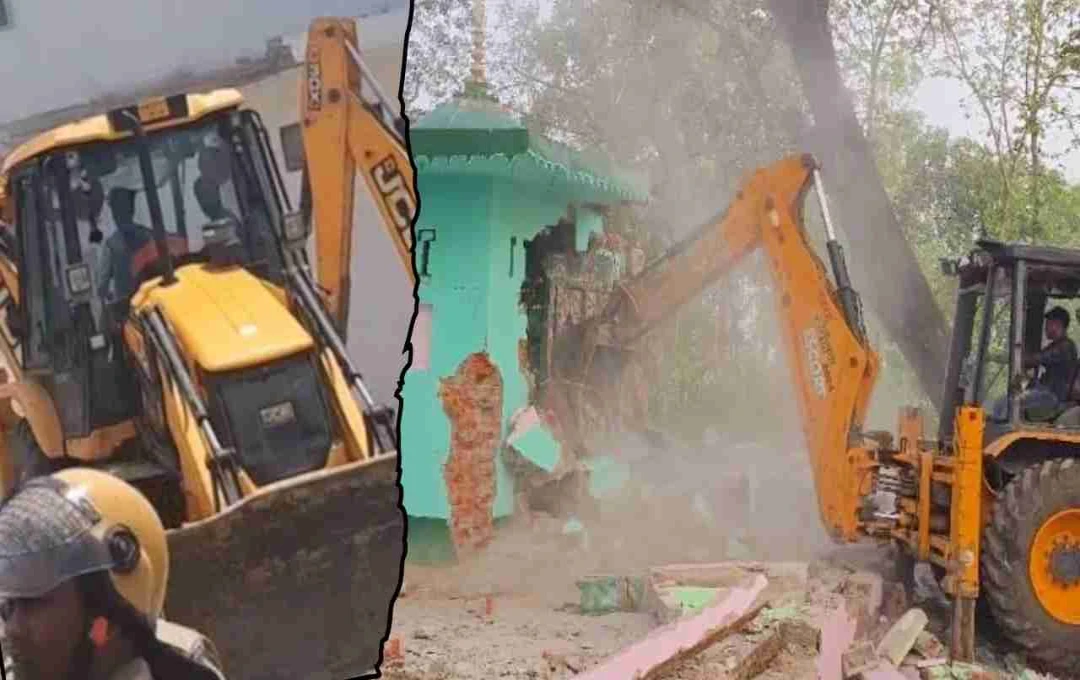Illegal Shrines and Houses Constructed in India-Nepal Border's No Man's Land; Administration Takes Bulldozer Action. Concerns Rise Regarding Smuggling and Security.
Chhangur Baba Case: The number of illegal constructions in the No Man's Land along the India-Nepal border is rapidly increasing. These constructions are emerging in the form of shrines, mosques, and permanent houses. In Shravasti district, one such shrine had its main entrance opening into India, while the rear section was in Nepal. This situation has become a matter of concern for security agencies and the administration.
Illegal Settlements Threaten Country's Security
These illegal settlements in No Man's Land have raised serious questions about the country's border security system. In Balrampur, Chhangur alias Jalaluddin, the mastermind of religious conversion, used these illegal settlements to reach Nepal. In addition, incidents of farming and construction of houses in No Man's Land have been reported in districts like Lakhimpur and Maharajganj.
Disappearing Border Pillars and Increasing Encroachment
From Pilibhit to Maharajganj, border pillars have either been broken or have disappeared in many places. In Shravasti district, there are no border pillars in the 10-kilometer stretch from Kakardari village to Holia village in Bahraich. In Maharajganj, border markers are missing from Pathalahwa SSB camp to the Gandak River. Taking advantage of this, people have illegally occupied the land.
Illegal Shrines in Bhartharoshangarh and Parsohana
In Bhartharoshangarh village of Shravasti, shrines and houses were built on No Man's Land. Local residents such as Ahmed Hussain, Meraj, Zakir, and Mehrunnisha had built permanent houses there. These were removed after strict action by the administration. In Parsohana village, there was a shrine with its front part in India and its rear part in Nepal.
Encroachment in the Name of Farming
In Sakardinhi village of Maharajganj district, farmers from Nepal are also cultivating land in India. A year ago, the India-Nepal No Man's Committee demarcated the boundary and installed bamboo and wooden pillars, but local villagers uprooted and threw them away. The situation is such that Nepali farmers are cultivating land up to a hundred meters inside Indian territory.

Illegal Plotting in Siddharthnagar Too
In the year 2020-21, illegal plotting was done on No Man's Land near Khunuwa Bazaar in Shohratgarh tehsil of Siddharthnagar district. An inquiry was conducted on the instructions of the government, and the concerned Kanoongo and Lekhpal were suspended. Along with this, bulldozers were used to demolish the illegal constructions.
Situation in Lakhimpur and Pilibhit
In Lakhimpur, farming is being done on No Man's Land from Khajuria to Gauri Fanta in Palia Kala. The highest encroachment has been found here from border pillar numbers 205 to 211. Pillar number 207 has completely fallen down. Meanwhile, incidents of illegal occupation of government land near the border have been reported in Pilibhit, Bahraich, and Balrampur districts, but encroachment has not yet reached No Man's Land.
Strict Initiative by DM Shravasti
DM (District Magistrate) of Shravasti, Ajay Kumar Dwivedi, has taken a major step to curb these illegal settlements. Now, a No Objection Certificate (NOC) from the concerned Circle Officer (CO) and Sub-Divisional Magistrate (SDM) has been made mandatory for the registration of any land within a 10-kilometer radius of the border. This step is significant in curbing illegal settlements.
Footpaths Being Used for Smuggling
Most of the needs of the villages in Nepal, located in the mountains along the India-Nepal border, are met by Indian markets. For this reason, in addition to daily necessities, narcotics, drugs, Canadian peas, liquor, wild wood, and other prohibited goods are being smuggled through footpaths. Several cases of smuggling have been caught in Sohgairwa of Maharajganj and Sohelwa forest of Shravasti.
SSB Vigilance
To prevent smuggling and encroachment, SSB (Sashastra Seema Bal) personnel are constantly monitoring the situation. They form teams and patrol the border areas and footpaths to prevent suspicious activities. Despite this, encroachment and illegal settlements on the borders remain a major challenge for the administration.














